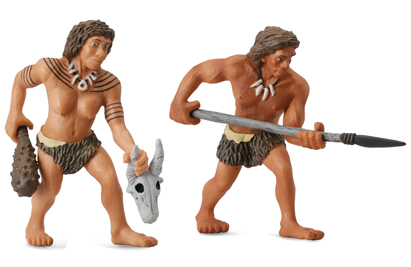Cave Women had a “Hand” in Prehistoric Art
Evidence Suggests Cave Women not Cave Men were Responsible for Cave Paintings
The contemporary image of a solitary cave man carefully painting an image of the animals he and his fellow hunters intended to catch is being challenged by a new study into European cave art. Cave women played a significant role, according to new research..
Professor Dean Snow and a team of researchers from Pennsylvania State University have compared the hand impressions left by our ancestors on cave walls with those of modern Europeans and concluded that many of the hand prints were from women. If the prints are female, then it could be suggested that the artworks, too were by the hand of the fairer sex. The hand print, being a symbolic gesture indicating ownership of the painting or perhaps staking a claim for recognition for their artwork, just as a painter may sign their work today.
Cave Women
Having studied the Palaeolithic paintings in French caves such as Pech Merle in south-western France and the cave at Gargas (French Pyrenees), the American team concluded that even after a “superficial” examination of published photographs there seemed to be plenty of female hands depicted on the cave walls.
Adult male hands are normally much larger in size than adult females, the smaller prints left behind by our ancestors on cave walls could have been made by woman or younger males or females. Such a revelation could challenge our existing understanding of the role of the sexes in early human settlements.
Professor Snow and his team used measurements of the hands of modern Europeans and compared these to the measurements taken of the hands from the cave walls. Using ratios between the digits to determine the sex, the team concluded that a number of the prints were female.
Commenting on the digit ratios, Professor Snow stated:
“The very long ring finger, it is a dead giveaway for male hands, a long index finger and a short little finger is very feminine”.
If you give a child a paint tray and ask him or her to make an impression of their hand, they normally place their hand in the paint and then press it down on the paper to make an impression of the hand. However, cave paintings depicting hands were made very differently. Hand prints were not used, instead the hand was used as a sort of stencil.
Scientists have suggested two techniques, firstly the hand was placed on the area of wall where the imprint was required and the paint spat out of the mouth to create a stencil affect. An alternative method of using a straw to blow the pigment-like paint onto the wall has also been proposed.
CollectA Neanderthal Models (Cave Man and Cave Woman)
To view the CollectA model collection: CollectA Age of Dinosaurs Popular Models.
Many of the cave paintings have been dated to between 40,000 and 20,000 years ago. If the artwork was made by women, then the current thinking regarding the role of females in cave society will have to be re-examined. Indeed, the artwork may have had a different purpose than that assumed previously. Many of the pictures depict oxen, horses and antelope, the sort of animals that our ancestors hunted. If the artwork was produced by the women of the clan, did they also participate in the actual hunts? Images of people hunting left on cave walls have always been interpreted as male, but perhaps if the role of women was greater in ancient cave clan society, perhaps they also took part in hunts.


